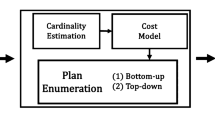Abstract
The computation of data cubes is one of the most expensive operations in on-line analytical processing (OLAP). To improve efficiency, an iceberg cube represents only the cells whose aggregate values are above a given threshold (minimum support). Top-down and bottom-up approaches are used to compute the iceberg cube for a data set, but both have performance limitations. In this paper, a new algorithm, called Multi-Tree Cubing (MTC), is proposed for computing an iceberg cube. The Multi-Tree Cubing algorithm is an integrated top-down and bottom-up approach. Overall control is handled in a top-down manner, so MTC features shared computation. By processing the orderings in the opposite order from the Top-Down Computation algorithm, the MTC algorithm is able to prune attributes. The Bottom Up Computation (BUC) algorithm and its variations also perform pruning by relying on the processing of intermediate partitions. The MTC algorithm, however, prunes without processing such partitions. The MTC algorithm is based on a specialized type of prefix tree data structure, called an Attribute–Partition tree (AP-tree), consisting of attribute and partition nodes. The AP-tree facilitates fast, in-memory sorting and APRIORI-like pruning. We report on five series of experiments, which confirm that MTC is consistently as fast or faster than BUC, while finding the same iceberg cubes.


























Similar content being viewed by others
References
Agarwal, S., Agrawal, R., Deshpande, P. M., Gupta, A., Naughton, J. F., Ramakrishnan, R., et al. (1996). On the computation of multidimensional aggregates. In Proceedings of the 22nd VLDB conference (pp. 506–521). Bombay, India.
Agrawal, R., & Srikant, R. (1994). Fast algorithms for mining association rules. In Proceedings of the 20th international conference on very large databases (pp. 487–499). Santiago, Chile.
Berry, M. J. A., & Linoff, G. (1997). Data mining techniques for marketing, sales, and customer support. Hoboken: Wiley.
Beyer, K., & Ramakrishnan, R. (1999). Bottom-up computation of sparse and iceberg cubes. In Proceedings of the 1999 ACM SIGMOD international conference on management of data (pp. 359–370). Philadelphia
Chen, Y., Dehne, F., Eavis, T., & Rau-Chaplin, A. (2005). PnP: Parallel and external memory iceberg cubes. In Proceedings of the 21st international conference on data engineering (pp. 576–577). Tokyo, Japan.
Cho, M., Pei, J., & Cheung, D. (2005). Cross table cubing: Mining iceberg cubes from data warehouses. In Proceedings of the 5th SIAM international data mining conference (pp. 461–465). Newport Beach, California, USA.
Chou, P. L., & Zhang, X. (2003). Efficiently computing the top N averages in iceberg cubes. In Proceedings of the twenty-sixth Australasian computer science conference (ACSC2003) (pp. 101–109). Adelaide, Australia.
Codd, E. F. (1993). Providing OLAP (On-line Analytical Processing) to user-analysts: An IT mandate. Hoboken: E. F. Codd and Associates.
Fayyad, U. M., Piatetsky-Shapiro, G., Smyth, P., & Uthurusamy, R. (Eds.) (1996). Advances in knowledge discovery and data mining. Cambridge: AAAI Press/The MIT Press.
Findlater, L., & Hamilton, H. J. (2003). Iceberg-cube algorithms: An empirical evaluation on synthetic and real data. Intelligent Data Analysis, 7(2), 77–97.
Gray, J., Chaudhuri, S., Bosworth, A., Layman, A., Reichart, D., Venkatrao, M., et al. (1997). Data cube: A relational aggregation operator generalizing group-by, cross-tab, and sub-totals. Data Mining and Knowledge Discovery, 1(1), 29–54.
Han, J., Pei, J., Dong, G., & Wang, K. (2001). Efficient computation of iceberg cubes with complex measures. In Proceedings of the 2001 ACM SIGMOD international conference on management of data (pp. 1–12). Santa Barbara, California.
Li, X. (2005). The Multi-Tree Cubing algorithm for computing iceberg cubes. M. Sc. Thesis, Department of Computer Science, University of Regina, Regina, SK, Canada, June.
Pendse, N., & Creeth, R. (1995). The OLAP Report. http://www.olapreport.com/Analyses.htm/.
Poosala, V. (1995). Zipf’s Law. Technical report, Computer Science, University of Wisconsin, Madison, Wisconsin, USA.
Ross, K. A., & Srivastava, D. (1997). Fast computation of sparse data cubes. In Proceedings of the 23rd international conference on very large databases (pp. 116–125). Athens, Greece.
Shao, Z., Han, J., & Xin, D. (2004). MM-Cubing: Computing iceberg cubes by factorizing the lattice space. In Proceedings of the 16th international conference on scientific and statistical database management (SSDBM 2004), June (pp. 213–222). Santorini Island, Greece.
Wang, K., Jiang, Y., Yu, J. X., Dong, G., & Han, J. (2005). Divide-and-approximate: A novel constraint push strategy for iceberg cube mining. IEEE Transactions on Knowledge and Data Engineering, 17(3), 354–368.
Xin, D., Han, J., Li, X., & Wah, B. W. (2003). Star-Cubing: Computing iceberg cubes by top-down and bottom-up integration. In Proceedings of the 26th international conference on very large databases (VLDB’03) (pp. 476–487). Berlin, Germany.
Zhao, Y., Deshpande, P., & Naughton, J. F. (1997). An array-based algorithm for simultaneous multidimensional aggregates. In Proceedings of the 1997 ACM SIGMOD international conference on management of data (pp. 159–170) Tucson, Arizona.
Author information
Authors and Affiliations
Corresponding author
Rights and permissions
About this article
Cite this article
Li, X., Hamilton, H.J., Karimi, K. et al. The Multi-Tree Cubing algorithm for computing iceberg cubes. J Intell Inf Syst 33, 179–208 (2009). https://doi.org/10.1007/s10844-008-0074-3
Received:
Revised:
Accepted:
Published:
Issue Date:
DOI: https://doi.org/10.1007/s10844-008-0074-3




